Posted by bob on Mar 4, 2012in Articles

Huck Finn and I shared the same dreams. Huck realized his in and around Hannibal, Missouri, I realized mine and grew into manhood in Dorchester, New Brunswick, Canada; Buck’s Flats, Johnson’s Mills, the Cherry Burton Road, the flat iron and the town square were playgrounds, and nature and her creatures my playmates.
The responsibilities of adulthood, parenting, meeting career goals and surviving life in the fast lane temporarily interrupted my relationship with Mother Nature.
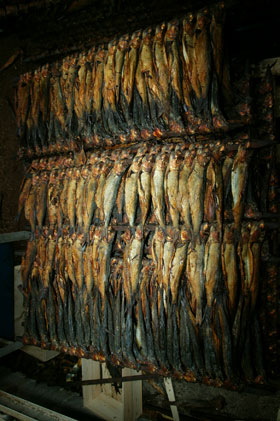 However, my maternal grandmother’s love of nature had proved infectious and returning to the cherished days of my youth was simply a matter of time.
However, my maternal grandmother’s love of nature had proved infectious and returning to the cherished days of my youth was simply a matter of time.
Visits to local zoos, an occasional stroll down a paved big city bike path, or arguing over sun bathing rights on an overpopulated freshwater beach didn’t fill nature’s call. The Maritimes, my home, was beckoning and I needed to return where breathing deeply was healthy, drinking from a babbling brook was a way of life and PCB, in the swimming hole, stood for pretty cute blonde, not some cancer causing chemical.
Home was a place where we ate shad, tuna, haddock and halibut and my day at the beach was shared with feisty sea gulls, not thousands of human ants.
As retirement beckoned, I enthusiastically packed my camera gear and headed for an extended stay in the woods, along the beaches and in the salt marshes of the Tantramar and Beaubassin eco-systems of Fundy’s tidal shore.
The scent of the sea was magnetic. My anticipation mounted, as I navigated each bend in the road that brought me closer and closer to l’Acadie and the Acadian paradise I had left years before.
My naiveté and belief that time had stood still quickly faded as I ran the gauntlet between Riviere du Loup and Edmunston where even money says you will hit a moose as you drive through the forested gauntlet. The revitalized Trans Canada Highway was leading me into paradise lost and not the Shangri-La of my youth. What had happened to the home I once knew”?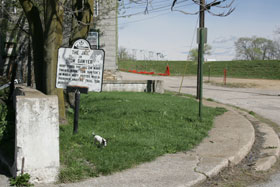
Pulp plants along the St. John River had poisoned this magnificent estuary. The Miramichi was no longer the pride of salmon rivers, the Restigouche and Madapedia rivers are fading memories of great salmon and trout runs and the tidal bore needs a push to make it up the dammed Petitcodiac.
Voracious clear-cutters had systematically violated every virgin timber stand in the province; foreign interests are making it worthwhile to deplete our fishing resources. Greed has dried up our cod. The once plentiful shad no longer populate the Bay of Fundy. There is a moratorium on Halibut fishing and our haddock stocks are waning.
Our beloved lobster is threatened. Contaminated shell fish warnings dominate our sea coasts and most of our oysters have a government mandated thirty day de-contamination “clean-up” process they must meet before they are deemed eatable. We sell our mercury laced tuna to the Japanese and Americans, only to buy back the polluted behemoths in a processed form, in neatly wrapped lunch packs we feed to our school age children. 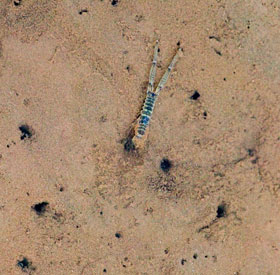
We have mastered the art of “roe-ing” the very future out of our herring schools. We squeeze their eggs into instant-freeze packs and send them of to the lucrative Asian market. However, as conscious stewards of our fishing resources, we quietly smoke and salt their shriveled lifeless remains and send them off to Haiti and the Dominican Republic, making us good stewards of a dying industry. What cannot be smoked, we sell to fish-processors who give us back fertilizer for our gardens.
We allow local and provincial governments to indiscriminately develop our coastlines while destroying their sensitive eco-systems, as we systematically dismantle funding resources for important environmental protection programs.
Why does it appear that Mother Nature finds herself in a constant battle with local politicians? Why is it that only a few of us are willing to reach out and take her by the hand and extricate her from the brink of ecological annihilation?
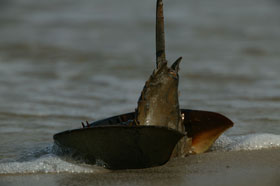
When I committed to conservation through photo-journalism eight years ago, I left behind a twenty-three career in professional sports and twelve years as a political activist in the United States. Apparently, my dream of becoming a retired, laid-back easy-going photographer is rapidly coming to a close. I had expected to create a homestead on the shores of Northumberland Strait at Cap Brule for my grandchildren with the hope that they would experience the same joys there that I had in Dorchester. Unfortunately, that may not happen if I do not get involved in the conservation and preservation challenges we are faced with here at home.
When I returned to the shores of Shepody Bay, my childhood playground, six summers ago, I cringed. The magnificent aerial displays of the million or so migrating semipalmated sandpipers that congregate there every from mid-July through August were gone. That number had dwindled to a quarter-million.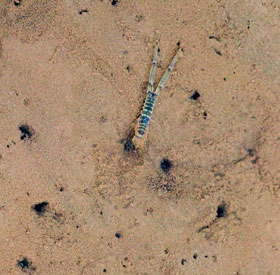
However, on the bluff overlooking Johnson’s Mills I had a providential and enlightening encounter with a diminutive leprechaun, from the offices of Environment Canada’s Wildlife Services bureau in Sackville.
Peter Hicklin was conducting his annual semipalmated sandpiper research along the shores of Buck’s Flats and the beaches I had patrolled as a boy. Being the opportunist I am, I moved alongside Hicklin and began listening for his impromptu comments….“I like that one,” he’d utter, to no one in particular. I quickly realized that “I like that one,” was a Hicklinism that meant take a picture, you fool! The aerial acrobatics provided by these feathered wonders was nothing less than special. To quote Hicklin, a veteran of twenty-five years of researching these birds, “This is the perfect day!”
Hicklin and I have spent countless hours discussing the future of shorebirds migrating through Atlantic Canada, and the stories are almost always the same….we, the private sector, must extend our helping hands to Mother Nature before it is too late!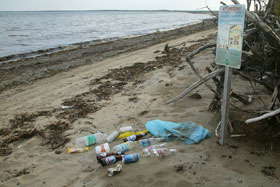
The building of the causeway/dam in Riverview has deprived the regions around Dorchester Cape, Buck’s Flats, Johnson’s Mills, Daniel Flats and Mary’s Point of the abundant food reserves it has supplied millions of migrating semipalmated sandpipers in the past. Instead of a rich fertile feeding ground for migrating shorebirds the region is becoming a vast burial ground for the lipid rich Corophium (shrimp like invertebrates) living there in the chocolate colored sub-straits.
Since the process of flushing the lake behind the dam began, worthless silt has accumulated on the feeding grounds denying the birds access to the reserves needed to affect their lengthy 4,000 km, non-stop flight to their South American wintering grounds.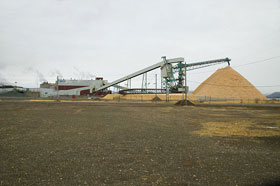
In 1950, as a boy of 14, I watched a million “peeps” swarm over the bay in their patented wing-tip to wing-tip acrobatic flight. By 2004 only 75,000 were on hand to carry-on the show.
Sad!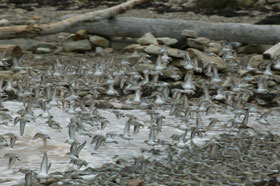
Sadder still is the knowledge that although New Brunswick hosts thirty-five species of migrating shorebirds on their way to and from their Artic breeding grounds each year their numbers are dropping precipitously.
Of the thirty-five species re-fueling on our shores, twenty-eight are in decline, thirteen are in significant decline and three are on the “species-at-risk” list. A recent scientific study reveled that the once abundant Red Knot will be EXTINCT by the year 2010.
The Red Knot has become a victim of uncontrolled over harvesting of the horseshoe crab in the Delaware Bay, off Cape May, New Jersey.
 Members of Environment Canada’s Wildlife Services departments have allowed me to listen, learn and respond to nature’s call for help. As a result of their generous efforts I have been able to capture and share thousands of educational images that help educate the public to some of the pressing problems before us.
Members of Environment Canada’s Wildlife Services departments have allowed me to listen, learn and respond to nature’s call for help. As a result of their generous efforts I have been able to capture and share thousands of educational images that help educate the public to some of the pressing problems before us.
Over time I hope you enjoy our walk through nature and the insights I have to offer. My wish is for you and me to work together to effect an integral change in how we go about conserving and preserving our environments for future generations.
The subject matter available is unlimited. I look forward to drawing you out of your comfort zone with thought provoking insights that will require you to act. No fence sitters allowed.
I invite you to walk with me through the devastated wastelands left by clear-cutters acting with impunity or serious government oversight. Let me introduce you to the splendor of my new found paradise I call the Acadian Peninsula or the magnificence of the 36-foot high tides of the Bay of Fundy.
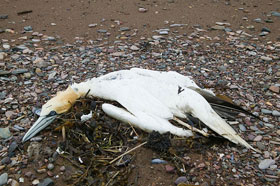 Come ride with me and my fishermen friends as we catch a wave, a boatload of fish and enjoy the cool morning sunrise under the Confederation Bridge between New Brunswick and Prince Edward Island. Or walk with me along the tidal sand bars of my home along the Northumberland Strait and be mystified by the hundreds of shorebirds sharing the beach with us.
Come ride with me and my fishermen friends as we catch a wave, a boatload of fish and enjoy the cool morning sunrise under the Confederation Bridge between New Brunswick and Prince Edward Island. Or walk with me along the tidal sand bars of my home along the Northumberland Strait and be mystified by the hundreds of shorebirds sharing the beach with us.
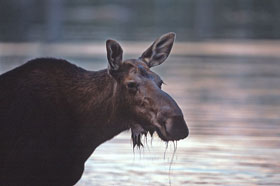 span>At day’s end I’d like to introduce you to the heavenly cuisine of Acadie and the people who know fish and how to prepare a succulent seafood meal that will leave you spoiled for all future fruits de mer.
span>At day’s end I’d like to introduce you to the heavenly cuisine of Acadie and the people who know fish and how to prepare a succulent seafood meal that will leave you spoiled for all future fruits de mer.
However, there is a dark side and you’ll need to see it for yourself. I’ll ask you to join me in making a difference there and in your own “backyard.” I’ll show you how bureaucrats are not good for the environment, why enforcement of environmental and wildlife protection laws is virtually impossible within the labyrinth of red tape.
I’ll take you inside the local lobster industry and explain why it is in dire straits.
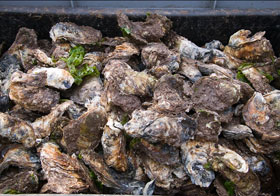 I’ll help you understand why saving the environment for our grandchildren is the most important commitment we can make for the future.
I’ll help you understand why saving the environment for our grandchildren is the most important commitment we can make for the future.
I am reminded of the days when coal miners, deep in the mine, hung a canary in a cage. As long as the canary sang, all was well. The moment the singing stopped or the bird died, everyone bailed out… they were next to go.
Welcome to my world! The “fat-lady” my still be singing…but the environmental canary maybe wailing its final song? Let’s make a difference!
















